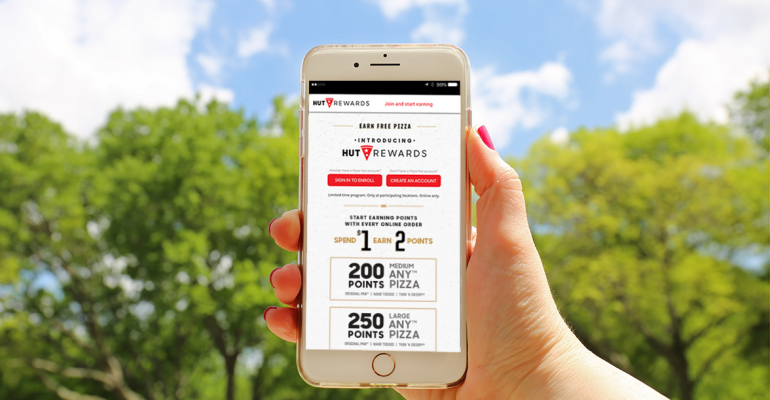Millennials are often considered the most influential generation of consumers. Their preferences have brought about change in almost every industry, including food. In the pizza category, specifically, millennials and their increasingly digital lifestyles have led pizza chains to think less like restaurants and more like tech companies.
At the heart of millennial consumers’ preferences, both within the pizza category and elsewhere, is convenience, according to Sastry Penumarthy, co-founder of restaurant marketing platform Punchh, whose partners include more than a dozen pizza chains including Pizza Hut, Aurelio’s, Cici’s, Pie Five and Pieology. But when it comes to pizza, they want chains to take convenience a step further and make it digital.
“The digital presence and the digital convenience is really critical,” he said.
To truly target millennial diners, pizza chains must have a presence online, in a mobile app and on social media, Penumarthy said. For millennials, companies that don’t have a mobile app or a presence on Facebook or Snapchat don’t exist, he said. And as a generation that has high participation rates in loyalty and rewards programs, pizza chains that incorporate that into their business models put themselves in a strong position in the millennial market.
According to Penumarthy, building convenience into loyalty programs can also benefit restaurants in the pizza category. Millennials, who are often the first customer group to sign up for such programs, want loyalty programs that reward them for signing up, and they want to know how soon they can redeem points and earn rewards, he said. Flexibility in loyalty programs is also important to millennial diners, who want to be able to choose how they redeem loyalty rewards.
Millennial consumers also crave personalized experiences when it comes to pizza, which is something Punchh’s partners are increasingly catering to.
“They’re realizing essentially that there is another thing that millennials want — a little bit more of a personalized touch,” Penumarthy said. “Convenience is one thing, but personalization is the second part.”
Millennials are more likely to have certain dietary preferences such as vegetarian or vegan, he said, and millennial consumers are more sensitive than other groups to whether brands meet those dietary needs. In the pizza category, chains should strive to allow millennials to self identify their preferences, and they should also be sure to equip themselves with tools that allow them to match those preferences to specific transactions and segment them in real time.
At Punchh, Penumarthy and his team work with pizza chains to create mobile apps and loyalty programs that are tailored to their diners. For example, for Aurelio’s, a standard mobile app experience wouldn’t be the right fit. With a customer base that is made up of a lot of families who order and dine inside of the stores, the company wanted to offer an entertaining experience that would keep customers engaged while encouraging return trips. The solution, Penumarthy said, was a mobile game that gives kids something to entertain them and allows families to earn points that can be redeemed on their purchases in the stores.
Punchh also helps pizza brands focus on what Penumarthy called “an ease of engagement” when crafting their mobile apps. For millennials, adding another mobile app to their phones isn’t an issue — what’s more important is offering an app that gives them the convenience of being able to quickly look up their orders, quickly look up their loyalty reward status and place pizza orders right on their phones. That “ease of engagement” is a key factor in targeting the millennial consumer segment.
This craving for digital convenience, led largely by millennial consumers, drove an overall change in the pizza category within the last decade, Penumarthy said, and Domino’s was the first major chain to answer that demand. He said that successful pizza chains keep two fundamentals in mind: make it easy to order pizza and reward customers for doing so, and make it easy to deliver the pizza. And Domino’s was the first pizza chain to turn to technology to do those things.
“They said, ‘Ok, to really win in this market, I can’t think of myself as a food business, I want to think of myself as a technology business,’” Penumarthy said.
That strategy ultimately proved successful, and other brands in the pizza category came to Punchh asking for help doing what Domino’s was able to do — incorporate the kind of digital technology that appealed to millennials, all while growing the number of transactions, the number of customers and the percentage of total transactions that were digital.
“That effectively means a good top plan and good bottom line,” Penumarthy said.
And when it comes to the millennial segment, the hard work that pizza chains are putting in pays off. According to Punchh, millennials are more likely to sign up for loyalty and other marketing programs than other generations. In addition, they are much more likely than other groups to refer friends to restaurants that they have positive experiences with.
__________________________________________________
If you enjoyed this article, join SmartBrief’s email list for more stories about the food and beverage industry. We offer 20 newsletters covering the industry from restaurants to food manufacturing. And be sure to follow us on Twitter for the latest industry news.
